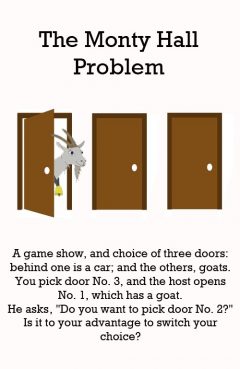Monty Hall Problem

Release Date: //1975
Country of Release:
Length:
MPAA:
Medium: Paradox
Genre:
Release Message: A game show, and choice of three doors: Behind one is a car; behind the others, goats. You pick door No. 1, and the host, who knows what's behind the doors, opens another door, say No. 3, which has a goat. He then says, "Do you want to pick door No. 2?" Is it to your advantage to switch your choice? Authored by Steve Selvin.
Description: The Monty Hall problem is a probability puzzle, loosely based on the American television game show Let's Make a Deal and named after its original host, Monty Hall. The problem was originally posed in a letter by Steve Selvin to the American Statistician in 1975 (Selvin 1975a), (Selvin 1975b). It became famous as a question from a reader's letter quoted in Marilyn vos Savant's "Ask Marilyn" column in Parade magazine in 1990 (vos Savant 1990a): Suppose you're on a game show, and you're given the choice of three doors: Behind one door is a car; behind the others, goats. You pick a door, say No. 1, and the host, who knows what's behind the doors, opens another door, say No. 3, which has a goat. He then says to you, "Do you want to pick door No. 2?" Is it to your advantage to switch your choice? Vos Savant's response was that the contestant should switch to the other door. (vos Savant 1990a) The argument relies on assumptions, explicit in extended solution descriptions given by Selvin (1975a) and by vos Savant (1991a), that the host always opens a different door from the door chosen by the player and always reveals a goat by this actionbecause he knows where the car is hidden. Leonard Mlodinow stated: "The Monty Hall problem is hard to grasp, because unless you think about it carefully, the role of the host goes unappreciated." (Mlodinow 2008) Contestants who switch have a 2/3 chance of winning the car, while contestants who stick have only a 1/3 chance. One way to see this is to notice that there is a 2/3 chance that the initial choice of the player is a door hiding a goat. When that is the case, the host is forced to open the other goat door, and the remaining closed door hides the car. "Switching" only fails to give the car when the player had initially picked the door hiding the car, which only happens one third of the time. Many readers of vos Savant's column refused to believe switching is beneficial despite her explanation. After the problem appeared in Parade, approximately 10,000 readers, including nearly 1,000 with PhDs, wrote to the magazine claiming vos Savant was wrong (Tierney 1991). Even when given explanations, simulations, and formal mathematical proofs, many people still do not accept that switching is the best strategy (vos Savant 1991a). Paul Erd s, one of the most prolific mathematicians in history, remained unconvinced until he was shown a computer simulation confirming the predicted result (Vazsonyi 1999). The Monty Hall problem has attracted academic interest from the surprising result and simple formulation. Variations of the Monty Hall problem are easily made by changing the implied assumptions, creating drastically different consequences. If Monty only offers the contestant a chance to switch when having initially chosen the car, then the contestant should never switch. If Monty opens another door randomly and happens to reveal a goat, then it makes no difference (Rosenthal, 2005a), (Rosenthal, 2005b). The problem is a paradox of the veridical type, because the correct result (you should switch doors) is at first sight ludicrous, but is nevertheless demonstrably true. The Monty Hall problem is mathematically closely related to the earlier Three Prisoners problem and to the much older Bertrand's box paradox.